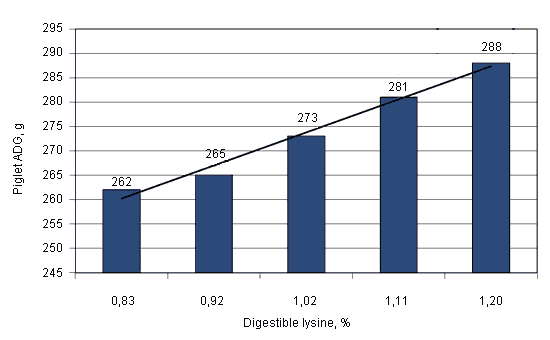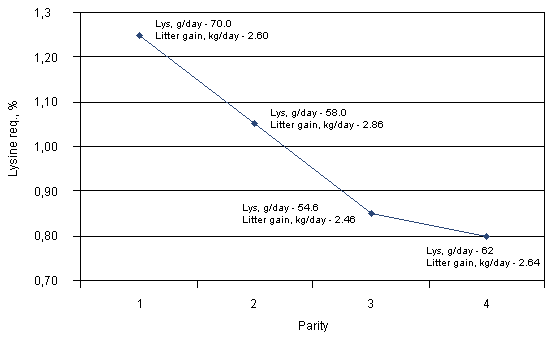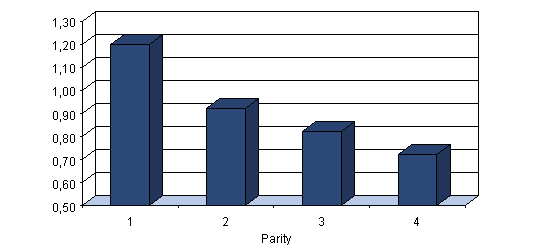Introduction
The modern white line sow has been selected for large litters and milk production and the evidence is clear on sow farms. Many sow farms have been increasing total born and weaning large litters with heavier pigs. With litter size continuing to improve and lactation length increasing to around 21 days, the demand for milk production must continue to increase to meet the increasing demand of heavier pigs. Modern sows can produce 10 to 12 kg milk/day (Aherne, 2007) with day 21 of lactation being the peak of production. In fact sows can produce more milk per kg of body weight than cows. If a 182 kg sow produces 11 kg of milk/day that would be 0.06 kg of milk per kg of body weight, a 909 kg cow can produce 45.5 kg of milk/day that would be 0.05 kg of milk per kg of body weight (Goodband, personal communication).

Milk production by the mammary glands is influenced by genetics and nutrition (Tri-State Swine Nutrition Guide, 1998). To maximize milk production in sows it takes many factors besides genetics and nutrition. Other factors include feed intake (frequency of feeding), environment (farrowing house temperature), length of lactation, body condition and water intake. One example of management that decreases milk production is restricting feed intake which will decrease milk production in gilts and sows (Pluske et al.) 1998.
With the correct selection of genetics, the right environment and management there can be an increase in milk production and therefore heavier weaning weights.
Potential for milk production in commercial units
As sows have been selected for greater milk production and productivity levels have been improved in commercial units, both milk production and litter weaning weights have increased substantially. In USA, there are examples of units where sows are weaning total litter weaning weights of over 76 kg on 20 day lactation (Table 1). With increased potential for milk production, management and nutritional factors must be changed to meet these demands for lactation.
Table 1. Commercial production for milk production (January – June 2007)a
| Trait | Response |
| Number of sows farrowed | 3029 |
| Total pigs born | 12,5 |
| Total pigs born alive | 11,6 |
| Litter birth weight, kg | 20,9 |
| Pre-wean mortality, % | 7,0 % |
| Pigs weaned/litter | 10,8 |
| Weaning age, days | 20,2 |
| Litter weaning weight, kg | 76,4 |
| Litter weight gain, kg/d | 2,74 |
| Milk production, kg/dayb | 10,99 |
aPIC Commercial Camborough 1070 Females located in Midwest USA.
bAssumes 4 g milk per gram of piglet growth.
Nutritional requirements for optimum milk production
Sows can achieve and maintain high levels of milk production throughout her productive life if given adequate levels of energy and nutrients. The most critical nutrients for maintaining optimum lifetime milk productivity are energy and amino acids. Table 2 shows the predicted lysine needs of prolific first litter sows based on current estimated milk production potential.
Table 2. Predicted lysine need for first parity sowsa
| Trait | Response |
| Body weight at farrowing, kg | 182 |
| Body weight at weaning, kg | 163 |
| Weight loss, kg | 11.1 |
| Estimated protein loss, % | 10 |
| Litter gain, kg/d | 2.74 |
| Lysine needs, g/d | |
| Maintenanceb | 2,5 |
| Milk productionb | 73.4 |
| Total | 75.9 |
| Lysine supplied g/d | |
| Protein mobilization, g/d | 2.5 |
| Diet, g/d | 73.4 |
| Feed intake, kg/d | 5.0 |
| Total lysine requirement, % | 1.22 |
a,bAdapted from Boyd et al., 2002 and Pettigrew, 1993.
These estimates for lysine needs have been validated in a series of studies designed to validate amino acid needs of PIC sows in commercial research conditions (Srichana, et al., 2007). In these studies, PIC C-22 sows in parities 1 through 4 were fed isocaloric (3.46 Mcal ME/kg) corn soybean meal lactation diets ranging from 0.95 % to 1.35 % total lysine. Diets were given to sows from day 112 of pregnancy throughout the 19 day lactation period. Feed intake was recorded with a computerized feeding system that insured ad-libitum feed intake. Figure 1. demonstrates the estimated lysine requirement ( % and g/day) and milk production (kg/day) for PIC C-22 sows in parities 1 through 4.
Figure 1. Effect of dietary lysine intake on piglet ADG (g/d) of gilt litters

Figure 2. Lysine requeriments of PIC sows


In summary of these sets of experiments, total lysine intakes of 70 g/day or 62 grams of SID lysine/day to optimize reproductive and milk production performance in PIC sows.
Because gilts eat 10 to 15% less than sows the percent SID lysine in the lactation must increase compared to a mature sow herd. Because we target 62 grams of SID lysine/day we must formulate based on feed intake and not only percent SID lysine. To prevent a Parity 2 dip we must feed the gilt properly and allow full feed after farrowing. First the gilt loses more than 10% of her body weight during lactation then the subsequent litter will suffer with low production.
| Body weight loss | P-value | |||
| Criteria | > 10 % | 0-10 % | Gained weight | |
| Number of sows | 31 | 191 | 66 | |
| WEI, d | 7.04 | 6.58 | 5.32 | 0.21 |
| Sows bred by day 7, % | 67.4a | 79.5b | 86.3b | <0.10 |
| Total born | 11.17a | 12.57b | 13.04b | 0.07 |
a,b,c Means within a row without a common suoerscript differ (P<0.5)
Figure 3. SID lysine requirement of PIC lactating sows.

In addition to lysine requirements, the maximum amount of synthetic lysine in lactation diets and the ideal ratios of other amino acids have recently validated (Shrichana et al., 2007). Not only will this improve performance but lower diet cost. Table 4 shows reproductive and milk production response to increasing levels of dietary synthetic lysine.
Table 4. Maximum use of crystalline amino acids in lactating sows.a
| L-lysine-HCL, % | 0.000 | 0.075 | 0.150 | 0.225 | 0.300 |
| Sow body weight change, kg | 1.4 | 2.9 | 3.0 | 4.6 | 4.4 |
| Litter gain, kg/d | 2.27 | 2.29 | 2.38 | 2.23 | 2.41 |
| WEI, d | 7.1 | 6.4 | 5.5 | 5.9 | 5.5 |
| Subsequent reproductive performance | |||||
| Total born, pig | 11.75 | 12.52 | 12.45 | 12.05 | 12.48 |
| Born alive, pig | 10.95 | 11.47 | 11.41 | 11.42 | 11.6 |
aShrichana et al, 2007. 283 Primiparous PIC C22 Sows. Total Amino acid ratios used in diets: Methinone+Cystine: Lysine, 58%; Threonine:Lysine,Tryptophan:Lysine, 18%; Valine:Lysine, 71%.
These studies indicate that up to 0.30 % synthetic lysine can be added to primiparous sow diets without deleteriously affecting reproductive or milk production performance. This response has also been validated in older parity sows (Allee, 2007 personal communication).
Table 5. With updated nutrition requirements we have included updated SID amino acid ratios.
| Lactation | ||||
| SID Amino Acid Ratio | Herd | Gilt | Herd | |
| Lysine | 100 | 100 | 100 | |
| Methionine + Cystine | 70 | 50 | 50 | |
| Threonine | 76 | 64 | 64 | |
| Tryptophan | 18 | 18 | 18 | |
| Valine | 68 | 75 | 75 | |
| Isoleucine | 58 | 56 | 56 | |



